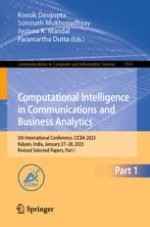2024 | Buch
Computational Intelligence in Communications and Business Analytics
5th International Conference, CICBA 2023, Kalyani, India, January 27–28, 2023, Revised Selected Papers, Part I
herausgegeben von: Kousik Dasgupta, Somnath Mukhopadhyay, Jyotsna K. Mandal, Paramartha Dutta
Verlag: Springer Nature Switzerland
Buchreihe : Communications in Computer and Information Science
